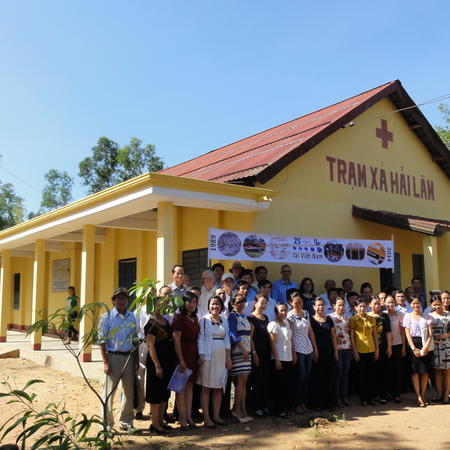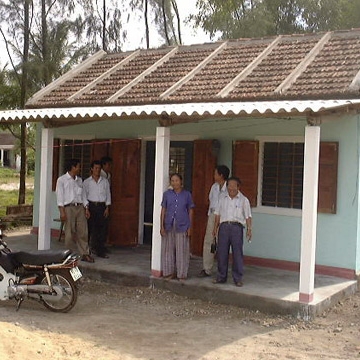Finding the urban crisis tipping point
DAKAR, 21 November 2013 (IRIN) - By 2015, three billion people will be living in urban slums according to UN Habitat. As the number of vulnerable people living in urban slums rises, aid agencies are struggling to identify the tipping point at which chronic urban vulnerability turns into a humanitarian crisis. IRIN spoke to aid staff to find out what they are doing about it.
Accurately tracking vulnerability is more complex in densely populated towns and cities, particularly in informal neighbourhoods such as slums, than it is in rural areas. Aid agencies and donors have therefore been slow to take on the challenge, inadvertently creating a rural-urban divide.
“Because we do not have the information, we do not intervene, and we allow people to live in conditions that we would consider unacceptable in rural settings,” said Marie Sardier, Action against Hunger (ACF)’s food security and livelihoods adviser in Paris.
Oxfam’s deputy humanitarian director Graham Mackay agrees: “In a rural area, we won’t intervene until a community has reached the point where it cannot cope anymore. I do not think we have enough understanding to apply this same method in an urban context.”
According to a 2012 article by Médecins sans Frontières adviser Elena Lucchi, traditional assessment approaches assume a level of geographical homogeneity in livelihoods and socio-economic status, which is common in rural areas but less so in poor urban ones. Further, in urban settings, vulnerable populations may be dispersed and may not want to be identified or assisted. While governments and individuals are often generous when it comes to fast-onset urban crises, such as the 2010 earthquake in Port-au-Prince, Haiti, and the current typhoon disaster in Tacloban, Philippines, they are not good at responding to the subtle changes that might signal an urban population’s gradually slide into crisis, for instance, rising food prices or shifting political or conflict situations, said the September 2013 edition of Field Exchange.
According to the Rome-based food-security cluster urban working group, national data collection does not pick up on this either, as it often has slow information collection cycles, and early warning systems are largely absent in urban slums.
Proportions versus numbers
One of the big problems in an urban setting is disaggregating complex data, as common emergency triggers do not always translate well in urban settings. For instance, the World Health Organization’s emergency malnutrition threshold is reached when 15 percent or more of children under age five face acute malnutrition - a metric that may not make sense in situations where the vulnerable live next door to the well-to-do. In such scenarios, the percentage of malnourished children may be very low while the actual number of malnourished children is very high. “In urban settings the search for percentages is meaningless,” said Jorge Castilla Echenique, health sector network global coordinator at the European Commission’s humanitarian aid arm (ECHO). This was the case in Nairobi, Kenya, in 2008 and 2009. The 2007-post-election crisis, combined with sudden job losses and escalating global food prices, pushed 62,000 children under age five into acute malnutrition in slum areas, but overall malnutrition rates remained relatively low. According to the government’s 2008-2009 district health survey, 1.9 percent of children were severely acutely malnourished and 3.5 percent had global acute malnutrition (GAM) in slum areas.
Another indicator of stress in slums was plummeting school attendance, said Anne O’Mahoney, head of Concern’s Kenya country office at the time. Despite this, donors hesitated to do anything. “They wanted to know where our information fit in with the values they use for rural poverty, like the 15 percent GAM rate,” she told IRIN. Mortality rates are also often tracked to indicate the magnitude of a crisis, but using them in urban settings is “inappropriate” as increases in mortality rates may appear low when spread over a larger population, said an October 2012 Save the Children report, Urban malnutrition: a review of food security and nutrition among the urban poor.
The question is whether existing indicators can be adapted to urban contexts or whether different indicators are needed, taking into account nuances such as crime rates, food and fuel prices, the influx of internally displaced people, sanitation and health data, and migration rates, among other issues, say urban vulnerability analysts. Aid agencies are finally experimenting with both approaches.
Identifying urban triggers
NGOs ACF, Concern and Oxfam have reviewed food security targeting methodologies to identify the best existing emergency food security indicators and how to adapt them to urban settings. They published their results through the Active Learning Network for Accountability and Practice (ALNAP) in July 2013.
Their recommendations include: undertaking assessments by neighbourhood; establishing baseline data to identify cost of living, crime rates, and migration rates before and after shocks; and using technology such as digital mapping tools to collect and organize information. The cluster coordination system should be used to adapt the phased food security assessment tool, commonly known as the IPC scale (integrated food security phase classification), to urban settings, they said. The IPC rates food security on a scale from stable to emergency. Finally, systems to measure urban vulnerability must be very responsive to change, which happens more quickly in cities than in rural villages, they stressed.
To move forward, agencies should identify five to 10 cities deemed most at risk of urban emergencies and set up working groups to map high-risk areas within them. Suggestions included: Nairobi; Port-au-Prince; Nepal, Kathmandu; Manila, Philippines; Dhaka, Bangladesh; Harare, Zimbabwe; and Gaza in the Occupied Palestinian Territories.
New tools
Concern in Kenya, meanwhile, is two years into a five-year project to develop new indicators to predict urban crises, called the Nairobi Urban Health and Demographic Surveillance System (NUHDSS), which will try to isolate what represents “real changes in the lives of the poorest of the poor urban populations,” said O’Mahoney. For instance, the NGO is collecting data on what would signal a change in the economic circumstances of a slums’ poorest, such as pulling children from school, the sale of critical assets, taking on risky work and extending a credit line. These indicators are being tested in Nairobi, and will eventually be tried in other at-risk cities in neighbouring countries. Save the Children, in a joint October 2013 study with King’s College on the Urban Futures Project, identifies areas where urban vulnerability tools should measure change: demographics, domestic capital, international capital, governance and regulatory processes, and violence and criminality.
State relations
NGOs stress the need to work with state governments to ensure urban response links into ongoing social protection and development programmes. Local authorities and civil society organizations are best placed to understand the socio-economic makeup of their populations, and the stresses different groups face, though some also note the need to ascertain local power dynamics to ensure local elites are not given undue influence.
But international NGOs are often unsure how to work with local partners on assessments, and partnerships require long-term engagement and financing, which donors often de-prioritize, says ACF. While coordinating among agencies, local agencies and governments in urban settings “is one of the principal recommendations” to have come out of the joint NGO study, it remains “our biggest challenge” said ACF’s Sardier. Donors often say urban response is a “structural issue” or a “policy issue”, said O’Mahoney, to excuse their reluctance to get involved. Urban response does risk becoming politicized, partly because the proximity of wealth and poverty can complicate distribution efforts, say observers.
While agreeing on the need to learn by working with local partners, Cyprien Fabre, head of ECHO for West Africa, says the risks of politicization are significant. In Nairobi in 2008-2009, neither the government nor civil society could access dedicated urban funding to respond to the mounting hunger and nutrition crisis. “The large donors are yet to develop urban funding strategies, and although there is interest in this area, progress is slow,” said the September 2013 Field Exchange. Since then, NGOs have worked with the government to develop its “urban nutrition strategy”. Still, “without clear consensus on what constitutes an urban emergency and what the exit strategy will be, then urban interventions will continue to be patchy and disconnected,” it concluded.
Big black hole: defining limits
Another difficulty for aid agencies and donors is to define their limits in urban settings. “It is like trying to define what is a neighbourhood; you never know where its limits are,” said Béatrice Boyer, head of research on urban humanitarian dynamics at French institute Urgence Recherche Développement. “Limits are even harder to define in slums which expand beyond administrative boundaries with no spatial limits,” she continued.
Perhaps these fluid boundaries, and the sense of possibly limitless vulnerability, make donors reluctant to finance urban work, posits O’Mahoney: “Humanitarian donors have said to me, ‘Urban is just a big black hole,’ and it is very hard to see how your money can have an impact in such a large part of humanity.”
Like many areas of international aid, urban crisis support often falls through the cracks, said UN Habitat’s Georges Deikun, who sits on the Geneva-based Inter-Agency Standing Committee (IASC)’s working group working on humanitarian urban challenges: “Development people who have the money do not do it because they think it is humanitarian work; and humanitarians do not do this kind of research because their job is to save lives.”
ECHO is trying to make the link between humanitarian crises and longer-term urban support. In the Guinean capital, Conakry, ECHO is helping local laboratories better prepare to detect and monitor cholera, and it is supporting the government to better lead cholera outbreak responses.
ECHO is also lobbying EU development funder DEVCO to get more involved in funding urban vulnerability. “Africa is the fastest-urbanizing continent,” said Deikun. “So dealing with urban poverty crisis is not just a developing country issue. It is also quietly becoming a major humanitarian issue.”











